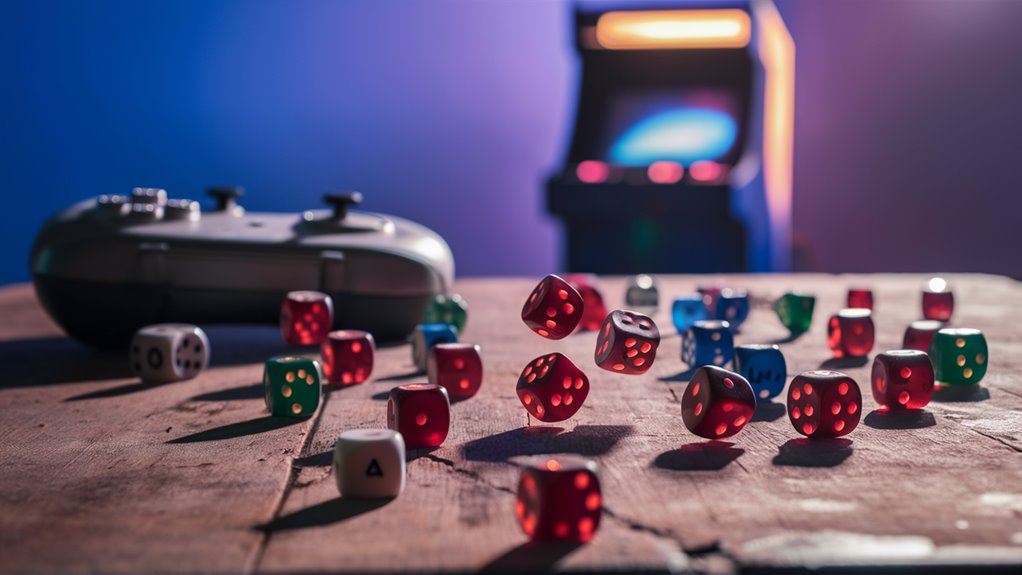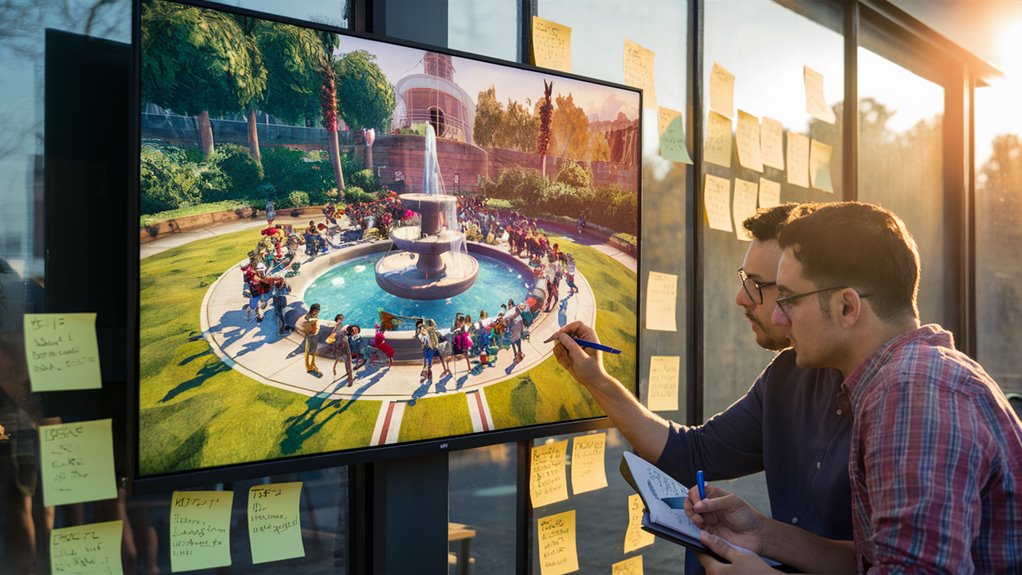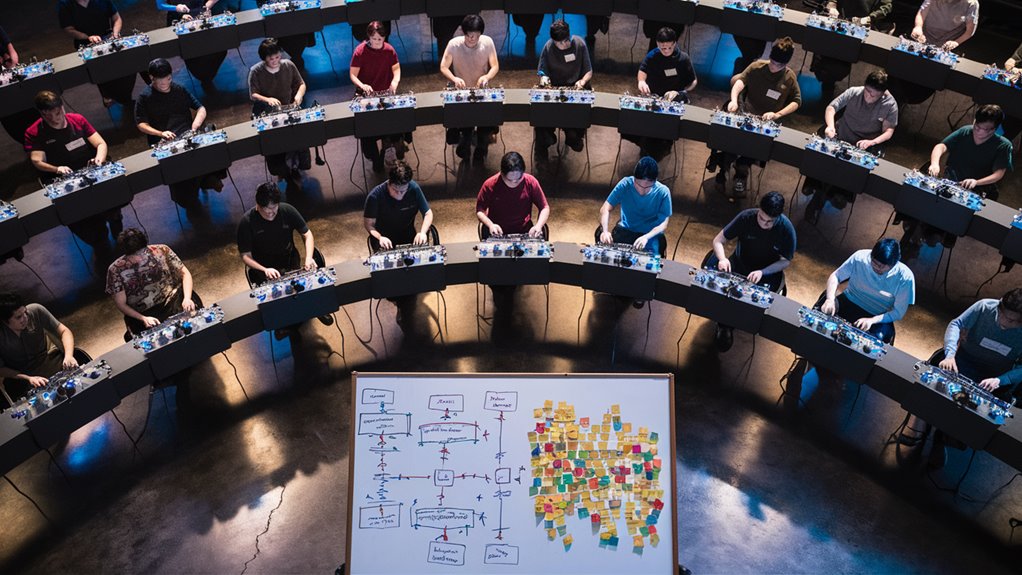
How Does Game Design Impact Player Retention?
Key Takeaways
- Game design mechanics directly influence how long players stay engaged
- Psychological elements like progression systems and reward loops are crucial retention drivers
- Social features and carefully balanced challenges create lasting player engagement
- Strategic design choices can transform short-term interest into long-term commitment
Game design’s relationship with player retention represents a critical intersection in modern gaming, where thoughtful design choices can dramatically influence player engagement periods from minutes to months. While surface-level elements like graphics and sound contribute to initial appeal, deeper psychological mechanisms drive sustained engagement.
Core Retention Mechanics
- Progress tracking and achievement systems
- Social interaction features
- Reward scheduling and feedback loops
- Balanced challenge progression
- Customization and personalization options
Psychological Design Elements
The invisible architecture of player retention relies on carefully crafted systems that tap into fundamental human motivations:
- Achievement Drive: Clear progression paths and milestone rewards
- Social Connection: Multiplayer features and community integration
- Mastery Development: Skill-based challenges and learning curves
- Personal Investment: Character customization and progress tracking
Strategic Implementation
Modern game design approaches player retention through multiple layers:
- Early Engagement
- Tutorial optimization
- Quick reward cycles
- Clear value demonstration
- Mid-term Retention
- Progressive challenge scaling
- Social feature integration
- Regular content updates
- Long-term Commitment
- Deep progression systems
- Community building
- Competitive elements
These design elements work together to create compelling experiences that encourage players to invest time and maintain interest in the game over extended periods.
Core Gameplay Loop Fundamentals

How Does a Core Gameplay Loop Drive Player Engagement?
Key Takeaways
- Core gameplay loops consist of three essential elements: action, reward, and progression
- Optimal loop timing ranges from 30 seconds to 3 minutes
- Successful loops create natural player motivation to repeat actions
- Clear feedback and meaningful rewards maintain player interest
Understanding the Three-Part Structure
The core gameplay loop combines player actions, rewards, and progression to create engaging gaming experiences.
This fundamental structure appears consistently across successful games, from simple mobile apps to complex console titles.
Essential Components of Effective Gameplay Loops
- Player Actions
- Must feel inherently satisfying to perform
- Examples: Tetris block rotation, Mario’s jumping mechanics
- Should provide immediate feedback to players
- Clear Rewards
- Points, resources, or character advancement
- Direct connection to player actions
- Consistent and meaningful feedback
- Progression Elements
- New levels or challenges
- Character upgrades or abilities
- Increasing complexity or difficulty
Optimal Loop Timing
The most effective gameplay loops typically follow these timing guidelines:
- Minimum: 30 seconds
- Maximum: 3 minutes
- Sweet spot: Creates “just one more” player motivation
Testing and Refinement
To ensure your gameplay loop effectiveness:
- Monitor player engagement patterns
- Track natural loop repetition
- Adjust action-reward balance based on player behavior
- Test with various player types
- Measure completion rates and retention
Reward Systems and Player Motivation

How Do Game Reward Systems Drive Player Motivation?
Key Takeaways
- Three core reward systems work together: extrinsic, intrinsic, and social rewards
- Balanced timing and progression of rewards maintains engagement
- Intrinsic rewards through mastery and discovery create deeper satisfaction
- Social features amplify reward impact through shared experiences
Understanding the Three Core Reward Systems
Game reward systems drive player motivation through a carefully balanced combination of extrinsic rewards (points, achievements), intrinsic rewards (mastery, discovery), and social rewards (competition, cooperation).
Successful games maintain engagement by blending these reward types strategically. When extrinsic rewards dominate, gameplay can feel shallow, while insufficient rewards may leave players directionless.
Timing and Progression Strategy
Strategic reward timing reinforces desired player behaviors throughout the game journey:
- Early rewards: Quick wins build initial momentum
- Mid-game rewards: Gradually increasing challenge maintains interest
- Late-game rewards: Higher effort requirements deliver greater satisfaction
- Random rewards: Unpredictable elements like loot drops create excitement
- Progression milestones: Guaranteed achievements provide steady motivation
Creating Meaningful Intrinsic Rewards
Deep player satisfaction comes from systems that enable genuine achievement:
- Complex combat mastery
- Puzzle-solving challenges
- Hidden area exploration
- Personal skill development
- Strategic decision-making
Maximizing Social Impact
Community features amplify reward satisfaction through:
- Shared achievements
- Cooperative challenges
- Competitive rankings
- Group milestone celebrations
- Social recognition systems
Social Mechanics That Drive Engagement

How Do Social Mechanics Drive Player Engagement in Games?
Key Takeaways
- Social gameplay mechanics form the foundation of modern player retention
- Multiple layers of social features create deeper community engagement
- Interdependent player roles and competitive elements boost long-term participation
- Community-driven systems significantly increase player investment
Understanding Core Social Mechanics
Social gameplay mechanics drive player engagement by combining community interaction with competitive elements.
Today’s most successful games implement multiple layers of social features, from basic player-to-player interactions to complex community systems. These include guild structures, trading economies, shared achievement tracking, and collaborative challenges.
Competitive Elements and Social Features
Leaderboards and ranking systems serve as powerful motivators for continued engagement. Players naturally seek to measure their progress against others, creating an inherent drive for improvement.
Modern games enhance this through:
- Friend list integration
- Real-time chat systems
- 메이저놀이터
- Social hubs for achievement display
- Customizable player profiles
Building Community Through Interdependence
Player interdependence creates lasting social bonds through:
- Specialized role systems
- Resource sharing mechanics
- Team-based challenges
- Mentorship programs
These mechanics encourage regular interaction between players, transforming solo gaming experiences into shared journeys. When players rely on each other’s abilities and resources, they develop stronger connections to both the game and its community.
Impact on Player Retention
Social mechanics boost retention rates by fostering:
- Emotional investment in player relationships
- Community responsibility
- Shared goals and achievements
- Regular social interaction
The combination of these elements creates a self-sustaining ecosystem where players remain engaged through their social connections and community involvement.
User Experience Design Principles

How Can User Experience Design Principles Improve Game Engagement?
Key Takeaways
- Intuitive navigation and clear feedback systems reduce player frustration
- Consistent interface elements across screens enhance usability
- Performance optimization directly impacts player retention
- Data-driven UX improvements lead to better engagement metrics
User experience (UX) design principles directly impact how players interact with and enjoy game features through intuitive navigation, clear feedback systems, and streamlined interfaces.
These elements work together to minimize cognitive load and maximize engagement.
Core UX Design Elements
Three essential principles drive effective game UX:
- Visibility
- Important features readily accessible
- Minimal menu complexity
- Clear visual hierarchy
- Consistency
- Standardized button placement
- Uniform icon design
- Predictable interactive elements
- Responsiveness
- Immediate visual feedback
- Clear audio cues
- Smooth transitions
Performance Optimization
Game performance significantly affects user experience:
- Progressive loading techniques
- Optimized asset delivery
- Smooth gameplay across devices
- Minimal loading times
Measuring UX Success
Track these key metrics to evaluate and improve UX:
- Time-to-action rates
- Error frequency
- Session duration
- Player retention
- Feature discovery
By monitoring these data points, designers can identify friction points and continuously refine the interface until players can navigate game elements effortlessly.
Regular testing and iteration based on user behavior helps create more engaging and accessible gaming experiences.
Progress and Achievement Architecture

How Do Progress and Achievement Systems Keep Players Engaged?
Key Takeaways:
- Progress systems combine short-term rewards with long-term goals for sustained engagement
- Visual tracking and clear metrics help maintain player motivation
- Balanced pacing prevents burnout while maintaining challenge
- Achievement integration with core gameplay creates natural progression
Creating Effective Achievement Architecture
Progress and achievement systems keep players engaged by mapping clear milestones that build momentum and satisfaction.
These systems work best when combining immediate rewards with longer-term objectives, creating multiple engagement layers that appeal to different player motivations.
Tracking and Visibility Elements
Players need clear ways to monitor their journey through:
- Visual progress indicators
- Completion percentages
- Milestone markers
- Achievement roadmaps
This transparency maintains motivation by showing both accomplished goals and upcoming challenges, letting players plan their gameplay strategy effectively.
Balanced Achievement Design
Achievement systems require careful pacing to maintain engagement:
- Major achievements spaced for sustained interest
- Minor rewards distributed frequently
- Multiple paths to success
- Skill-based and exploration-based options
- Direct connection to gameplay mechanics
- Natural integration with narrative elements
The progression curve must balance challenge with accessibility, preventing both frustration and boredom.
Each achievement should feel meaningful and earned, connecting directly to core gameplay elements rather than existing as arbitrary checkpoints.
This natural integration drives stronger player retention and creates a more cohesive gaming experience.
Player Psychology in Game Design

How Does Player Psychology Drive Effective Game Design?
Key Takeaways
- Player motivation centers on three core needs: autonomy, competence, and relatedness
- Variable reward systems maintain engagement through unpredictable reinforcement
- Social features and FOMO mechanics drive player retention
- Gradual complexity scaling keeps players in an optimal flow state
Understanding Core Player Motivations
Game design fundamentally connects with player psychology through three essential human needs: autonomy, competence, and relatedness.
Successful games create experiences that satisfy these psychological drivers, leading to deeper player engagement and satisfaction.
Leveraging Reward Psychology
Variable reward schedules form a powerful foundation for maintaining player interest. Much like slot machines, unpredictable reward patterns prevent player fatigue while sustaining engagement.
The goal-gradient effect amplifies this dynamic – players naturally increase their efforts as they get closer to achieving rewards.
Social Elements and Player Retention
Players respond strongly to social validation mechanisms within games. Features like:
- Leaderboards
- Guild systems
- Achievement sharing
- Time-limited events
- Exclusive rewards
These social anchors create community connections while tapping into FOMO (Fear of Missing Out) psychology to maintain consistent player engagement.
Managing Cognitive Load
Effective game design carefully balances complexity and challenge through:
- Progressive difficulty scaling
- Intuitive learning curves
- Manageable information presentation
- Strategic challenge pacing
This measured approach to complexity helps maintain players in their optimal flow state – engaged but not overwhelmed.
Community Building Through Design

How Can Game Design Build Stronger Gaming Communities?
Key Takeaways
- Community building mechanics must integrate naturally into core gameplay loops
- Successful social features balance group interdependence with player autonomy
- Essential elements include communication tools, shared spaces, and collaborative challenges
Gaming communities thrive when social features are woven directly into the core gameplay mechanics, creating organic player interactions rather than forced social elements.
Successful games achieve this through carefully designed systems like shared objectives, cooperative missions, and player-driven economies that naturally encourage collaboration.
Balancing Social and Solo Play
The most effective community designs create meaningful interdependence while preserving individual choice. Consider these proven approaches:
- Guild systems that reward group achievements without penalizing solo players
- Optional trading mechanics that enhance gameplay but aren’t progression requirements
- Flexible group content that accommodates different play styles and time commitments
Essential Community Building Elements
- Communication Tools
- In-game chat systems with customizable channels
- Voice chat integration for real-time coordination
- Friend lists and social networking features
- Shared Spaces
- Social hubs for player gatherings
- Achievement showcase areas
- Community event locations
- Collaborative Content
- Group challenges that create shared experiences
- Team-based objectives with meaningful rewards
- Cross-player progression systems
Community Management Tools
Empowering players to moderate their own communities proves crucial for long-term sustainability.
Critical features include:
- Robust reporting systems for handling disruptive behavior
- Clear community guidelines and expectations
- Player-driven moderation tools
- Recognition systems for positive community contributors
This combination of thoughtful design elements and player empowerment creates self-sustaining communities that continue growing long after launch.
Retention Metrics and Analytics

How Do You Track and Analyze Player Retention in Games?
Key Takeaways
- Day 1, Day 7, and Day 30 retention metrics reveal player engagement patterns
- Behavioral analytics help identify critical churn points and friction areas
- Real-time data monitoring enables quick optimization of player experience
- Cohort analysis provides insights into different player segment behaviors
Essential Retention Metrics
Tracking player retention starts with monitoring key performance indicators (KPIs) across multiple timeframes. The most critical metrics include:
- Day 1 retention: Initial player return rate
- Day 7 retention: Short-term engagement measurement
- Day 30 retention: Long-term player commitment
- Monthly Active Users (MAU): Overall player base health
- Daily Active Users (DAU): Regular engagement levels
Understanding Player Behavior
Analyzing player churn requires examining specific data points:
- Session length patterns
- Level completion rates
- Player progression speed
- Behavioral metrics by player segment
- Cohort performance analysis
Advanced Analytics Implementation
Real-time analytics tools provide comprehensive insights through:
- Engagement pattern tracking
- Monetization metric analysis
- Social interaction monitoring
- Player behavior mapping
- Feature performance evaluation
The combination of these metrics enables data-driven decisions for:
- Game feature optimization
- Player experience improvements
- Content update planning
- Retention strategy refinement
- Long-term engagement enhancement
Monetization and Player Value

How Can Games Successfully Monetize While Maintaining Player Value?
Key Takeaways
- Effective monetization balances revenue generation with positive player experience
- Player segmentation and lifetime value analysis drive strategic monetization decisions
- Non-intrusive monetization methods like cosmetics and battle passes preserve gameplay integrity
- Balanced monetization systems support both paying and non-paying player communities
Understanding Player Value and Revenue Generation
Game monetization success depends on converting player engagement into revenue while preserving core gameplay experiences.
Strategic monetization focuses on delivering player value through meaningful purchase options like cosmetic items, battle passes, and quality-of-life features that enhance rather than disrupt gameplay mechanics.
Analyzing Player Behavior and Spending Patterns
Understanding player lifetime value (LTV) reveals critical insights into spending behaviors and monetization opportunities. Key metrics include:
- Average revenue per user (ARPU)
- Player conversion rates
- Purchase frequency
- Feature popularity
These metrics help identify revenue drivers and optimize pricing strategies across different player segments.
Implementing Sustainable Monetization Systems
Free-to-play games often rely on “whale” players?a small percentage generating significant revenue.
However, long-term success requires:
- Optional subscription models
- Seasonal content releases
- Non-intrusive advertising
- Fair pricing structures
- Balance between premium and free features
This approach maximizes revenue potential while maintaining player satisfaction and healthy retention rates.
Regular analysis and adjustment of monetization strategies ensure continued alignment with player expectations and market trends.